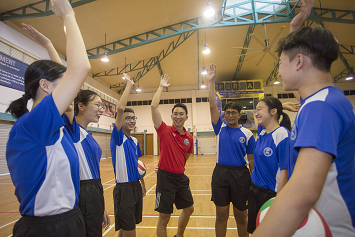Mr Chong Wee Er Timothy, Northbrooks Secondary School, Outstanding Youth in Education Award 2022 Recipient
Tell us a story that captures the kind of teacher you are.
“No, I don’t want to try.”
This was a common refrain from my students in PE lessons when I encouraged them to try something new, such as performing a volleyball serve or batting a softball.
The students were afraid that they would fail and their classmates would laugh at them. So instead of trying, they would often play the fool in class, like throwing a football into a basketball hoop or chit-chatting with their peers.
I felt that I had to address the root of the issue, which was the fear of failure and the lack of resilience in my students. They would rather not try at all, than try and risk failing.
The first step was to develop my students’ abilities to regulate their emotions. As the theory of Positive Psychology states, understanding why we even feel the way we feel is the first step in changing our behaviour.
“I felt that I had to address the root of the issue, which was the fear of failure and the lack of resilience in my students.”
Mr Chong Wee Er Timothy
The first Positive Psychology Intervention (PPI) tool I introduced was the Emotional Thermometer. This required students to share how they are feeling at a certain point in the lesson, and more importantly, to try to identify why they were feeling the way they felt. Students would first share their feelings anonymously through a Google form, which encouraged them to respond honestly. I would then read out some of the statements, selecting both positive and negative sentiments, so that students know that they are not alone in the way they feel. As a safe and trusted space is built where the students get more comfortable with each other, I observed that they began to gain confidence in sharing their feelings openly, too.
 Developing students’ abilities to regulate emotions via the theory of Positive Psychology.
Developing students’ abilities to regulate emotions via the theory of Positive Psychology.
“I didn’t know he felt anxious about learning a new sport too” and “I identify with his fear of looking foolish in front of everyone…” were two of the common responses received.
One by one, as the students opened up, the honest sharing over a period of three months brought the class closer. As students identified with the struggles and efforts of their classmates, the laughter and giggles following others’ failed attempts faded. Students became more willing to step out of their comfort zones to try, even if it meant potentially ‘failing’ in front of their peers. It even resulted in the deepening of many friendships. Disruptive behaviours that I used to see were replaced with stronger peer support and encouragement to try.
A heartening moment I witnessed was three boys reaching out to teach a more reserved classmate how to perform a volleyball forearm pass during one of the lessons. What was surprising about this was that these three more skilful boys would normally not want to play with others who were less proficient in playing sports, let alone step up to coach a fellow classmate who was facing a challenge with catching a volleyball. Likewise, the reserved student who would usually not want to socialise was buoyed by encouragement and volleyball tips from the more advanced players.
This scene was more meaningful to me than the best basketball throw or football pass.
Describe a teaching method or tool you have found effective.
Every week, I get my students to take up different roles in the sport that they are learning. For instance, one week, a particular student could be team captain or coach and the next, they could be the equipment manager or referee.
Everyone gets an opportunity to lead or to take charge of something regardless of their proficiency in playing that sport.
I have found this to be very effective in getting students to take ownership of their learning and to build their socio-emotional skills. Students not only appreciate the different aspects of the sport, but also the varying roles required for the team sport to be played effectively.
They come to realise that the success of a game depends on every member playing their part. For instance, if a team captain is unable to relay the activity instructions accurately to the teammates, the teammates would not know what to do. If the equipment manager does not properly set up the equipment required for the activity, the implications can be far-reaching.
Through this approach adopted from the Sports Education Model, I see my students becoming more active in their learning.
As the roles are rotated, students are more empathetic of the challenges faced in the various roles and learn to collaborate with each other to ensure the sport is played smoothly.
In addition, students are encouraged to share a strength they have observed in their classmates at the end of each lesson. This is an application of the ‘strength spotting tool’, which students grew to appreciate as they felt that their actions were recognised by their peers. For instance, when a student was unable to execute a volleyball serve well but continued to practice the skill, a classmate commented on his fortitude.
 Mr Chong guides students to appreciate not just the different aspects of the sport, but also the varying roles.
Mr Chong guides students to appreciate not just the different aspects of the sport, but also the varying roles.
Which school project or initiative are you especially proud of?
The badminton team I oversee organised a “Giving Back to Chong Pang” Values-in-Action (VIA) project, where they planned and conducted a three-day badminton workshop for the residents of Chong Pang – almost entirely on their own.
The team had been using the community centre facilities to practise, so we thought we would thank the residents by offering to teach them badminton. Once the idea was conceptualised, the team of 20 students took on the project with gusto while I deliberately took a step back so that the students could play a more proactive role in leading one another through the process.

I recall one incident during the preparation stage, when the publicity team put in great effort to design the banner advertising the badminton workshop, only to have it rejected by the Community Centre. The students were not disappointed by the rejection, but they took the feedback positively and put together another banner, which they and the Community Centre were pleased with. In the end, the workshop received about 20 sign-ups from the residents.
In preparation for the workshop, five student ‘coaches’ were identified for the workshop, even though none of them were CCA leaders. They were excited to be chosen and eagerly took up their new roles.
On the day itself, the coaches appeared calm and confident, though later, they shared that they had spent a sleepless night, wracked by both excitement and nervousness.
“What if we can’t cope tomorrow?” “What if we cannot manage the crowd?” “What happens if my coaching is not up to standard?”
“One of the coaches, who was a shy and quiet student, mentioned that having a positive attitude had helped her teach with greater confidence. The others agreed that it was okay to be nervous as long as one adopts a positive learning attitude.”
On the day itself, the coaches were clear in their instructions to the participants whose ages ranged from 8 to 17-years. They also snuck one another encouraging nods. The entire process from registration to coaching ran smoothly, and the students were showered with shouts of ‘Great job!’ and high-fives from the public as the first session concluded.
One of the coaches, who was a shy and quiet student, mentioned that having a positive attitude had helped her teach with greater confidence. The others agreed that it was okay to be nervous as long as one adopts a positive learning attitude. My wish to see these students step up and lead was fulfilled.
For weeks following that, the badminton workshop was all that these students talked about. It gave them such a sense of accomplishment. I also observed that our subsequent training sessions improved as the team grew in unity and they also appreciated the role of the coach, having stepped into those shoes themselves.
It is my personal belief that competitions should not be the only platform to showcase students’ skills. Playing sports is not just about winning and being judged at events. The “Giving Back to Chong Pang” VIA project is an example of other platforms where students could put their skills into use. Through the process, the students not only got to apply their skills and to develop soft skills like communication and teamwork, but more importantly, they also learnt that that they could make a difference to others in their own capacity. This also helped to build a sense of confidence and how they value themselves, as seen from the students’ sharing and reflections.
Next step: Now that the pandemic has eased, my students are planning a badminton clinic for teachers.






